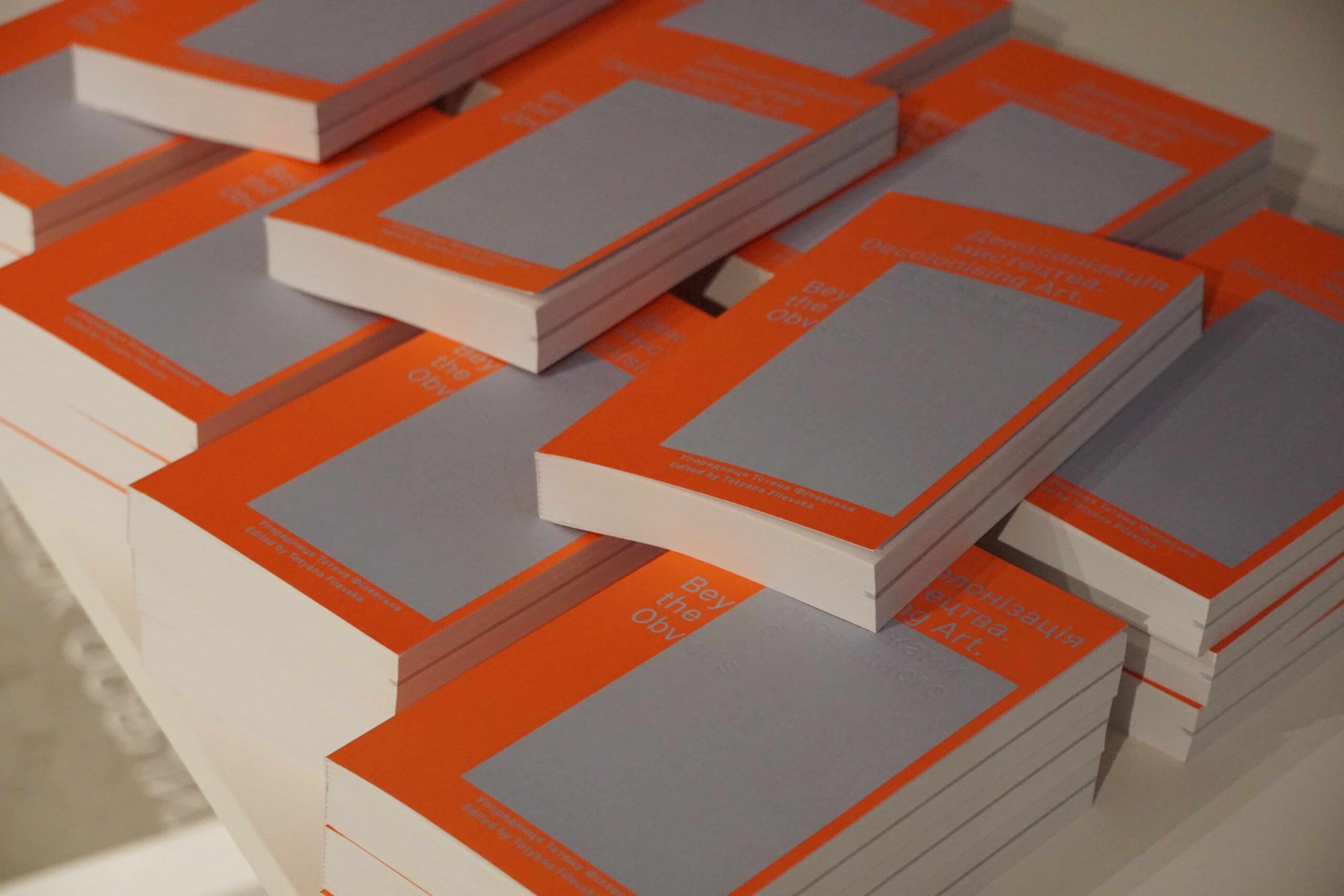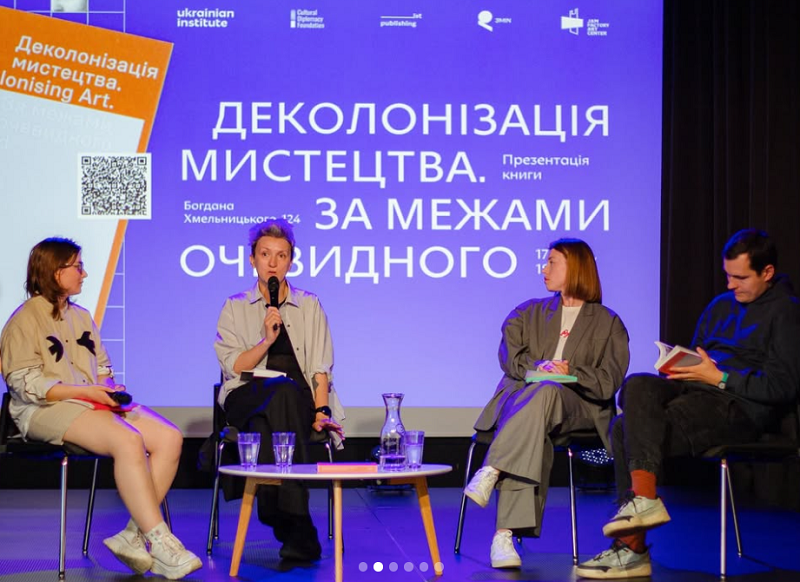
Breaking the boundaries of the obvious
The idea for this collection of essays came to life months after the authors delivered their speeches in Venice in the spring and autumn of 2022. It has become a kind of documentation of a significant chapter in our history. When our existence was threatened by Russia’s full-scale invasion of Ukraine, we could not plan anything in advance. The first year of the war – as many call it, to distinguish it from the war in eastern Ukraine and the occupation of Crimea, which began in 2014 and continues to this day – remained uncertain until the de-occupation of Kharkiv and Kherson Regions at the end of 2022. But in the first weeks and months of the full-scale invasion, we were all deeply concerned about the outcome of the war and the fate of Ukraine.
The world also witnessed a new incarnation of the crime of genocide – it could watch the massacres in Bucha, Izyum and Mariupol unfold online. It would take months before we could regain the ability to think about the future and begin planning again for the weeks, months and years ahead. This publication was born from the understanding that the knowledge gained was worth the effort invested in organising a programme of this scale and, in particular, this book – despite the acute lack of resources.
We were preparing this collection in 2024, two years after the onset of the full-scale invasion. We were tired and exhausted, devastated and anxious, living in constant tension caused by air raid sirens, missile attacks, power shortages and blackouts. We spent nights in bomb shelters and lost loved ones every day. We did not know when we would be able to feel safe again, or when we would start processing our traumas – or when we would be able to reflect on art and culture again, instead of constantly confronting the brutal and ugly reality of war.
Russia’s aggression will not end soon, so we have no choice but to continue our daily struggle – some in the trenches, some in the media, some at international art biennials. We do nothing that we do not believe to be of utmost importance, and this collection of essays is no exception.
By the time we began work on this edition, our resilience had also given rise to new habits and rituals: we had learned how to work in bomb shelters with generators and EcoFlow devices, and after sleepless nights of rocket attacks, we took our children to school and went to our offices as usual to meet deadlines. And culture flourished. Tickets to theatre premieres sold out in minutes, new bookstores opened almost weekly, people queued to visit exhibitions of Ukrainian art, and the Khanenko Museum – damaged by a Russian missile – hosted a five-hour contemporary opera the day before.
When we first conceived the idea of a public programme for the 59th International Art Biennale in Venice – in the early days of the invasion in late February – we did not fully grasp the scale of the disaster. We were in a state of shock, making decisions as though nothing had happened, while our instincts were urging us to flee or to fight. It seemed almost irrational to announce that the curatorial team of Lizaveta German, Maria Lanko and Borys Filonenko would continue working on the Ukrainian national pavilion together with the artist Pavlo Makov. At the time, Makov and Filonenko’s hometown of Kharkiv was (and still is) under intense artillery fire, while Russian armoured personnel carriers were advancing on Kyiv – the home cities of Lanko and German – from all directions. It is difficult to comprehend how anyone could focus on an international art event under such circumstances.
Yet they succeeded in organising the project and invited the Ukrainian Institute to develop a public programme. The idea was born on 1 March 2022 during a conversation about the possible use of the Russian pavilion, which remained empty after its team cancelled participation. Faced with the choice between leaving the building unused or holding a discussion about Russia’s decolonisation, the decision became clear: we would involve other pavilions, adopt decolonialism as a central theme, and examine works of art through the lens of Russia’s war against Ukraine.
A multi-week programme was planned for the spring of 2022, with the support of the Venice Biennale curator and team, curators from other national pavilions, partners and friends. On 22 April, the first event was held at the Piccolo Theatre in the Arsenale. Under my moderation, Borys Filonenko, Alevtina Kakhidze, Serhiy Plokhyy and Olesya Ostrovska-Lyuta discussed the impact of the Russian war on the global artistic context. Reflecting on the situation in Ukraine, Ostrovska-Lyuta remarked that the daily task of those who remained in Kyiv was to “stay alive and hold on” and “not let yourself become indifferent. You stop feeling things the way you felt them a month ago… Don’t make melodrama and… reflect on your experience.” Kyiv dominated global headlines. Events in Ukraine also began to shape the discourse within the art world. Just days before the Biennale’s opening, an exhibition of works by Maria Prymachenko was added after the museum in Ivankiv, which housed some of her pieces, was destroyed by a Russian missile. The Biennale’s curator, Cecilia Alemani, announced that the exhibition would make space for an additional Ukrainian pavilion in the Giardini, and within weeks, the architect Dana Cosmina constructed a temporary pavilion named Piazza Ucraina (Ukraine Square). It resembled a burnt-out building with a pile of sandbags at its centre – a reference to the protection of cultural heritage sites from bombs in Ukrainian cities.
Until 2022, there remained a naïve belief that empires were a thing of the past, that democracy was a universal value, and that the horrors of twentieth-century European genocide would not recur. Francis Fukuyama’s “end of history” thesis – widely circulated when I was a student at Kyiv National University in the early 2000s – shaped the worldview of many, despite the warnings of those outside Western Europe and the United States: the Chechen wars in the 1990s and 2000s, the creeping occupation of Sakartvelo in 2008, the annexation of Crimea and the war in eastern Ukraine in 2014. Even the emergency pavilions at previous Biennales – such as the 2015 Georgian pavilion, Crawling Borders – passed with little consequence. It is heartening that Piazza Ucraina exists in 2022, but has anything truly changed? Can art transform reality? And if not, what role can art play in times of global crisis? The programme, conceived as a platform to confront these pressing questions, made some progress towards answering them. At the very least, it challenged our understanding of what is normal – those things previously deemed self-evident. Decolonisation has opened a path through unfamiliar and terrifying terrain, leading to an emancipated future we could scarcely have imagined.

When the first conversation about the programme took place in April 2022, during preparations for the Venice Biennale’s opening, the world remained stunned by the atrocities committed by Russian forces in Bucha. At the same time, the battle for Mariupol continued. Defenders of Azovstal were besieged inside the plant, surrounded by overwhelming Russian troops. On 16 May, the Ukrainian leadership gave the order for the remaining defenders to surrender. Most remain in Russian captivity, and at least 53 were killed in July 2022 in Olenivka. Yet, in April, Ukrainian helicopters managed to fly deep behind enemy lines, delivering food and ammunition. Those sheltering underground without food, water, heat or electricity recorded messages and posted them online. We were watching genocide unfold live on our smartphones, while sipping prosecco or cappuccino and admiring the breathtaking beauty of Venice.
It took me two weeks to persuade the Ukrainian artist Alevtina Kakhidze to come to the Biennale. Since 24 February 2022, she had not left her home in Muzychi, on the outskirts of Kyiv. She slept in the basement with her two dogs and cat, listening to the sound of explosions from artillery and bombs just 5–7 kilometres away. After everything her family had endured, she could not bear the thought of leaving them behind – nor could she understand how anyone could still create or discuss art. But I managed to find the right words. I convinced Alevtina to leave her home for the first time since the full-scale invasion and to come to Venice.
It took her more than 24 hours to reach her destination, as there were no flights from Ukraine. She took an overnight train from Kyiv to Poland, travelled by train across Poland to the airport, flew to Venice, and finally took a boat to the island. I saw Alevtina walking along the shoreline from St Mark’s Square to the Giardini. She looked exposed and disoriented, watching the people enjoying themselves with genuine amazement. I greeted her and gave her a hug.
“Why?” she asked. “Why do all these people have to bear the burden of our disgusting war? It’s so beautiful here. They don’t need to see it. They don’t need to know how terrible and vile this war is.” She wanted to shield these beautiful people, to protect them just as the Ukrainian army protects Europe from Russian aggression. “They need this. You must tell them how disgusting war is to protect them. Your art can warn them.”
We began this programme when the world still doubted whether Ukraine could stand against Russia. We needed to find a language to articulate current events, to explain why Europeans – accustomed to indulging in Russian culture and cheap gas – failed to recognise the threat from Moscow and its assault on Ukrainian and European freedom and justice.
The programme ended in November, by which time the Kyiv and Kharkiv Regions had been liberated, and bodies from countless unmarked graves in the forest near Izyum had been exhumed. In October, Ukrainian forces struck the Crimean Bridge. The final event of the programme took place just a week after the liberation of Kherson. Russia’s defeat was in the air. Ukraine had become David facing down Goliath. There was far less doubt about who would ultimately win the war.
What remains uncertain is how long it will take, and how many more lives it will cost.
I thank everyone who made it possible.
Tetyana Filevska is the Creative Director of the Ukrainian Institute, an art manager, curator, and writer. She holds a degree in philosophy with a focus on contemporary art and the history of twentieth-century Ukrainian art. She is the author of the books Kazimir Malevich. Kyiv Period 1928–1930, Kazymyr Malevych. Kyiv Aspect, and Dmytro Horbachov. Incidents. She curated the public programme of the Ukrainian Pavilion at the 59th Venice Biennale, dedicated to decolonisation.
The publication Decolonising Art. Beyond the Obvious was created by the Ukrainian Institute, the Foundation for Cultural Diplomacy, and ist publishing, with the support of the ZMINA Foundation.








